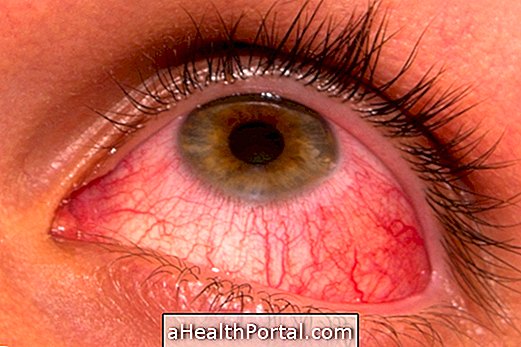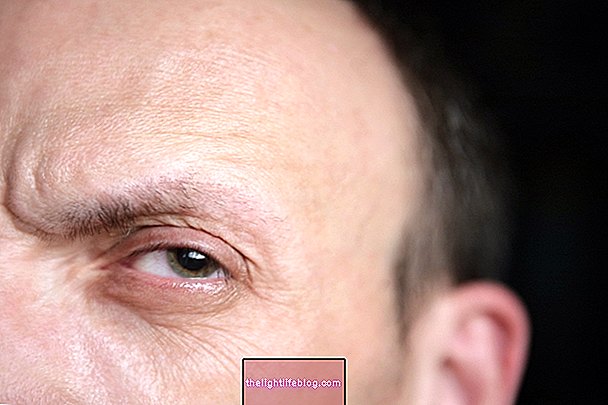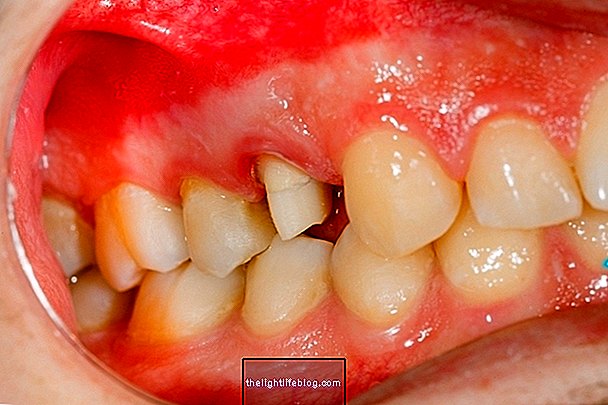Viral conjunctivitis is an inflammation of the eye caused by viruses such as adenovirus or herpes, for example, which cause symptoms such as redness in the eye, excessive remixing, itching, and tears.
Although viral conjunctivitis often disappears without requiring specific treatment, it is highly contagious and therefore, while the eye is red there is a high chance of catching the infection for other people, being recommended to stay at home.

Main symptoms
The symptoms that usually arise in the case of a viral conjunctivitis are:
- Intense itching of the eyes;
- Excessive tear production;
- Redness in the eye;
- Hypersensitivity to light;
- Feeling of sand in the eyes
Usually these symptoms appear in one eye and after 3 or 4 days the other is contaminated and develops the same symptoms, which remain for 4 to 5 days.
In addition, there are some cases in which a sore tongue appears in the ear and is caused by the presence of the infection in the eyes, gradually disappearing with the symptoms of the eye.
How to confirm the diagnosis
The symptoms of viral or bacterial conjunctivitis are very similar and so the best way to know if it really is viral conjunctivitis is to go to the ophthalmologist. The doctor can make the diagnosis only with evaluation of the symptoms, but also can make a test of the tears, where it looks for the presence of viruses or bacteria.
How Viral Conjunctivitis Begins
The transmission of viral conjunctivitis occurs through contact with the secretion of the eye of the infected person or the sharing of objects, such as handkerchiefs or towels, that have come in direct contact with the affected eye. Other ways to get viral conjunctivitis are:
- Use the makeup of a person with conjunctivitis;
- Use the same towel or sleep on the same pillow as another person;
- Share glasses or contact lenses;
- Give hugs or kisses to someone with conjunctivitis.
The disease is transmissible for the duration of the symptoms, so the person with conjunctivitis should avoid leaving the house because it can transmit the disease very easily, even through a simple handshake, since the virus can be on the skin when it itches the eye, for example.

How is the treatment done?
Viral conjunctivitis usually goes away on its own, without specific treatment. So, generally, the treatment of this type of conjunctivitis is done only to relieve the symptoms.
For this, it is quite common for the ophthalmologist to recommend the use of moisturizing drops or artificial tears, 3 to 4 times a day, during the symptomatic period, to relieve itching, redness and sand sensation in the eyes. In rare cases, in which the person is very sensitive to light, the doctor may also recommend ocular ointments with corticosteroids, for example.
Also, washing your eyes several times a day or applying cold compresses over the eye also helps to relieve symptoms. To dry the secretion of the eyes, it is ideal to wear tissues as they are disposable, and you should wash your hands whenever you use them. If on waking it is very difficult to open the eyes, due to the fact that the eyelids are glued together, it is recommended to put a wet gauze with water over the eyes and only then try to open them.
Most Used Remedies for Viral Conjunctivitis
There are different types of remedies that can be used in case of conjunctivitis:
- Moisturizing eye drops or artificial tears: Lacril, Dunason, Optrex moisturizing or Systane Ultra;
- Ointments with corticosteroids: Dexamethasone ophthalmic or Prednisolone;
- Antiviral drops: acyclovir .
Corticosteroid ointments and antiviral drops may only be used under the guidance of an ophthalmologist, as they can cause various side effects if not used correctly. Normally, antiviral drops are only used in conjunctivitis caused by herpes.
Does viral conjunctivitis leave sequelae?
Generally, viral conjunctivitis does not leave sequelae, but blurred vision may occur. To avoid this consequence, it is recommended to only use eye drops and artificial tears that have been recommended by the doctor and, if any difficulty in the vision is identified, one should return to the ophthalmologist.


























